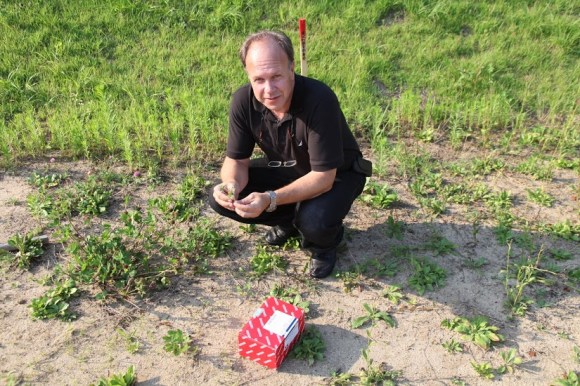
Dr. Timothy Mousseau, professor of Biological Sciences at the University of South Carolina and researcher for the Chernobyl and Fukushima Research Initiative, presented new findings to the International Ornithological Congress in Tokyo last week that suggest radiation contamination around Fukushima Daiichi, even at low levels, is negatively impacting biodiversity and wildlife populations.
Mousseau and his collaborators have been monitoring radiation levels at 1,500 sites and bird populations at 400 points across Fukushima over the last 3 years. The lay of the land and dispersal patterns of radioactive matter have created a very heterogenous situation in the Fukushima exclusion zone, meaning areas of high radiation lie right alongside areas of low radiation. By controlling for other environmental factors, the scientists can apply a rigorous statistical analysis to predict what the population in a particular area should be.
Using this method, Mousseau et al have found both the number of birds and the variety of species drop off as radiation levels rise, and more importantly, that there is no threshold under which the effect isn’t seen.
This is counter to what both the Japanese government and the United Nations Scientific Committee on the Effects of Atomic Radiation have said regarding low-level radiation. In a report on the situation in Fukushima released in April, UNSCEAR said, “Exposures of both marine and terrestrial non-human biota following the accident were, in general, too low for acute effects to be observed,” although the report goes on to hedge that “changes in biomarkers cannot be ruled out.” Indeed, Mousseau and the Wild Bird Society of Japan report seeing partial albinism in Fukushima birds, a condition rarely seen outside of Chernobyl (see photo above).
▼ Mousseau collecting samples in Fukushima
Citing years of research in Chernobyl and meta-analysis of studies on areas with naturally occurring radiation, Mouseau says, “Contrary to government reports, there is now an abundance of information demonstrating consequences, in other words, injury, to individuals, populations, species, and ecosystem function stemming from low-dose radiation.”
What we need now, he continues, is more funding for research into what this means in the long term, for the flora and fauna of Fukushima, as well as for the people who live alongside them.
Source: Timothy Mousseau
Images: Courtesy Timothy Mousseau


 Fukushima Prefecture Produces First Thesis on the Effects of Internal Radiation Exposure: Children of Fukushima Unaffected?
Fukushima Prefecture Produces First Thesis on the Effects of Internal Radiation Exposure: Children of Fukushima Unaffected? Radiation fears as report shows Fukushima fir trees to be growing strangely
Radiation fears as report shows Fukushima fir trees to be growing strangely New study shows wildlife thriving in areas evacuated after Fukushima nuclear meltdown【Video】
New study shows wildlife thriving in areas evacuated after Fukushima nuclear meltdown【Video】 Ramen restaurant’s English menu prices are nearly double its Japanese ones, denies discriminating
Ramen restaurant’s English menu prices are nearly double its Japanese ones, denies discriminating Here’s what our bachelor writers ate over the New Year’s holiday in Japan
Here’s what our bachelor writers ate over the New Year’s holiday in Japan How to get a job in anime with Studio Ghibli director Hayao Miyazaki
How to get a job in anime with Studio Ghibli director Hayao Miyazaki Shiba Inu bring the cute and cuddly, leave us all wanting a snuggle
Shiba Inu bring the cute and cuddly, leave us all wanting a snuggle Dragon Quest Burgers and Slime drinks are coming to McDonald’s Japan【Video】
Dragon Quest Burgers and Slime drinks are coming to McDonald’s Japan【Video】 Japan chooses its top 3 night views【Photos】
Japan chooses its top 3 night views【Photos】 Mackerel chips coming to Japan…for gamers!
Mackerel chips coming to Japan…for gamers! That time our reporter’s classmate became possessed by a dead child at school
That time our reporter’s classmate became possessed by a dead child at school Young photographer and his gear steal the show at cosplay event, kind of looks like Doc Ock
Young photographer and his gear steal the show at cosplay event, kind of looks like Doc Ock What makes a good boss in Japan? Workers sound off in survey
What makes a good boss in Japan? Workers sound off in survey Japanese beef bowl chain Sukiya’s 2026 Smile Box lucky bag basically pays for itself
Japanese beef bowl chain Sukiya’s 2026 Smile Box lucky bag basically pays for itself Starbucks Japan ready to get Year of the Horse started with adorable drinkware and plushies【Pics】
Starbucks Japan ready to get Year of the Horse started with adorable drinkware and plushies【Pics】 Hayao Miyazaki says Happy New Year to Studio Ghibli fans with new art for Year of the Horse
Hayao Miyazaki says Happy New Year to Studio Ghibli fans with new art for Year of the Horse Cup Noodle tries an authentic Jiro-style ramen, but something’s not quite right
Cup Noodle tries an authentic Jiro-style ramen, but something’s not quite right Top Japanese cosplayer Enako returns to Comiket after 6 years, creates mayhem with admirers
Top Japanese cosplayer Enako returns to Comiket after 6 years, creates mayhem with admirers The best Starbucks Japan Frappuccinos we want to drink again in 2026
The best Starbucks Japan Frappuccinos we want to drink again in 2026 We revisited Sweets Paradise after a decade to see if Japan’s dessert buffet still delivers
We revisited Sweets Paradise after a decade to see if Japan’s dessert buffet still delivers That time Seiji called JASRAC to ask why he didn’t get paid royalties for his song being on TV
That time Seiji called JASRAC to ask why he didn’t get paid royalties for his song being on TV Pizza Hut Japan’s hot lucky bags are perfect for a New Year’s pizza party
Pizza Hut Japan’s hot lucky bags are perfect for a New Year’s pizza party Majority of Japanese mayors say foreign residents are essential but most see good and bad effects
Majority of Japanese mayors say foreign residents are essential but most see good and bad effects 7-Eleven Japan starts new temporary luggage storage service in over 300 branches
7-Eleven Japan starts new temporary luggage storage service in over 300 branches Disillusionment at Tsukiji’s tourist-target prices led us to a great ramen restaurant in Tokyo
Disillusionment at Tsukiji’s tourist-target prices led us to a great ramen restaurant in Tokyo Starbucks teams up with 166-year-old Kyoto doll maker for Year of the Horse decorations【Photos】
Starbucks teams up with 166-year-old Kyoto doll maker for Year of the Horse decorations【Photos】 Tokyo considering law requiring more trash cans following litter increase in heavily touristed area
Tokyo considering law requiring more trash cans following litter increase in heavily touristed area Tokyo’s Tsukiji sushi neighborhood asks tour groups to stay away for the rest of the month
Tokyo’s Tsukiji sushi neighborhood asks tour groups to stay away for the rest of the month Tokyo event lets you travel back in time, for free, to celebrate 100 years since Showa era start
Tokyo event lets you travel back in time, for free, to celebrate 100 years since Showa era start Japan may add Japanese language proficiency, lifestyle classes to permanent foreign resident requirements
Japan may add Japanese language proficiency, lifestyle classes to permanent foreign resident requirements Sanrio theme park in Japan announces plans to expand into a Sanrio resort
Sanrio theme park in Japan announces plans to expand into a Sanrio resort Lacquerware supplier to emperor of Japan and Pokémon team up for new tableware
Lacquerware supplier to emperor of Japan and Pokémon team up for new tableware Survey asks foreign tourists what bothered them in Japan, more than half gave same answer
Survey asks foreign tourists what bothered them in Japan, more than half gave same answer Japan’s human washing machines will go on sale to general public, demos to be held in Tokyo
Japan’s human washing machines will go on sale to general public, demos to be held in Tokyo Japan’s deadliest food claims more victims, but why do people keep eating it for New Year’s?
Japan’s deadliest food claims more victims, but why do people keep eating it for New Year’s? We deeply regret going into this tunnel on our walk in the mountains of Japan
We deeply regret going into this tunnel on our walk in the mountains of Japan Studio Ghibli releases Kodama forest spirits from Princess Mononoke to light up your home
Studio Ghibli releases Kodama forest spirits from Princess Mononoke to light up your home Major Japanese hotel chain says reservations via overseas booking sites may not be valid
Major Japanese hotel chain says reservations via overseas booking sites may not be valid Put sesame oil in your coffee? Japanese maker says it’s the best way to start your day【Taste test】
Put sesame oil in your coffee? Japanese maker says it’s the best way to start your day【Taste test】 No more using real katana for tourism activities, Japan’s National Police Agency says
No more using real katana for tourism activities, Japan’s National Police Agency says Starbucks Japan reveals new sakura drinkware collection, inspired by evening cherry blossoms
Starbucks Japan reveals new sakura drinkware collection, inspired by evening cherry blossoms Updated cherry blossom forecast shows extra-long sakura season for Japan this year
Updated cherry blossom forecast shows extra-long sakura season for Japan this year
Leave a Reply